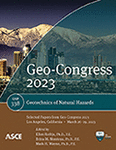Landslide Susceptibility Mapping Using Machine Learning Methods: A Case Study in Colorado Front Range, USA
Publication: Geo-Congress 2023
ABSTRACT
Due to the complex nature of landslides, statistically based landslide susceptibility mapping has been widely used to evaluate slope failure risk for landslide-prone areas. This study evaluates the capability of different machine learning (ML) methods for landslide susceptibility mapping (LSM) in mountainous regions in the Colorado Front Range. A well-documented and georeferenced landslide inventory for the Colorado Front Range area was used to construct the database for developing and testing ML models. Nine landslide contributing factors were collected for the present study based on the availability of geophysical data and the type of landslides that occurred in the study area. These landslide causative factors represent hillslope geometries, surface hydrology, and soil conditions. Five commonly used ML models were evaluated: logistic regression (LR), support vector machine (SVM), decision tree (DT), random forest (RF), and gradient boosting machine (GBM). The cross-validation technique was used to evaluate the model performance. All the trained models reflected the relationship between landslides and their causative factors in the study area based on cross-validation results. It was found that the performance varied among the ML models; the RF model exhibited the worst performance due to possible overfitting, and the RF and the GBM models achieved the highest performance. The trained models were subsequently used to predict the landslide susceptibility for the entire study area and generate a landslide susceptibility map. The landslide susceptibility map can provide situational awareness of potential landslide hazards within the Colorado Front Range area and provide guidelines for future decision-making.
Get full access to this article
View all available purchase options and get full access to this chapter.
REFERENCES
Anderson, R. S., C. A. Riihimaki, E. B. Safran, and K. R. MacGregor. (2006). “Facing reality: Late Cenozoic evolution of smooth peaks, glacially ornamented valleys and deep river gorges of Colorado’s Front Range.” in Tectonics, Climate and Landscape Evolution, edited by S. D. Willett et al., Spec. Pap. Geol. Soc. Am., 398, 397–418.
Breiman, L. (2001). “Random Forests.” Mach. Learn., 45 (1): 5–32.
Birkeland, P. W., R. R. Shroba, S. F. Burns, A. B. Price, and P. J. Tonkin. (2003). “Integrating soils and geomorphology in mountains—an example from the Front Range of Colorado.” Geomorphology, 55 (1–4): 329–344.
Baum, R. L., J. W. Godt, and W. Z. Savage. (2010). “Estimating the timing and location of shallow rainfall-induced landslides using a model for transient, unsaturated infiltration.” J. Geophys. Res., 115 (F3).
Coe, J. A., J. W. Godt, M. Parise, and A. Moscariello. (2003). “Estimating debris-flow probability using fan stratigraphy, historic records, and drainage-basin morphology, Interstate 70 highway corridor, central Colorado, U.S.A.” 3rd International Conference on Debris-Flow Hazards Mitigation: Mechanics, Prediction, and Assessment, 1085–1096.
Coe, J. A., J. W. Kean, J. W. Godt, R. L. Baum, E. S. Jones, D. J. Gochis, and G. S. Anderson. (2014). “New insights into debris-flow hazards from an extraordinary event in the Colorado Front Range.” GSA Today, 24(10), 4–10.
Dickinson, W. R., M. A. Klute, M. J. Hayes, S. U. Janecke, E. R. Lundin, M. A. McKittrick, and M. D. Olivares. (1988). “Paleogeographic and paleotectonic setting of Laramide sedimentary basins in the central Rocky Mountain region.” Geol. Soc. Am. Bull., 100 (7): 1023–1039.
Guzzetti, F., P. Reichenbach, M. Cardinali, M. Galli, and F. Ardizzone. (2005). “Probabilistic landslide hazard assessment at the basin scale.” Geomorphology, 72 (1–4): 272–299.
Fischer, E. M., and Knutti, R. (2015). “Anthropogenic contribution to global occurrence of heavy precipitation and high-temperature extremes.” Nature Climate Change, 5(6), 560–564.
He, X., Y. Hong, H. Vergara, K. Zhang, P.-E. Kirstetter, J. J. Gourley, Y. Zhang, G. Qiao, and C. Liu. (2016). “Development of a coupled hydrological-geotechnical framework for rainfall-induced landslides prediction.” J. Hydrol., 543: 395–405.
Hengl, T., et al. (2017). “SoilGrids250m: Global gridded soil information based on machine learning.” PLoS One, 12 (2): e0169748.
Kirschbaum, D. B., R. Adler, Y. Hong, S. Hill, and A. Lerner-Lam. (2010). “A global landslide catalog for hazard applications: method, results, and limitations.” Natural Hazards, 52(3), 561–575.
Kuhn, M., and K. Johnson. (2013). Applied predictive modeling. Springer New York, New York, NY.
Marr, J. W. (1961). “Ecosystems of the east slope of the Front Range in Colorado.” University of Colorado Series in Biology, 8:1–134.
Montrasio, L., and R. Valentino. (2008). “A model for triggering mechanisms of shallow landslides.” Nat. Hazards Earth Syst. Sci., 8 (5): 1149–1159.
Mirus, B. B., et al. (2020). “Landslides across the USA: occurrence, susceptibility, and data limitations.” Landslides, 17 (10): 2271–2285.
Ma, Z., G. Mei, and F. Piccialli. (2021). “Machine learning for landslides prevention: a survey.” Neural Comput. Appl., 33 (17): 10881–10907.
Pedregosa, F., et al. (2011). “Scikit-learn: Machine Learning in Python.” Journal of Machine Learning Research: JMLR, 12(85), 2825–2830.
Reichenbach, P., M. Rossi, B. D. Malamud, M. Mihir, and F. Guzzetti. (2018). “A review of statistically-based landslide susceptibility models.” Earth Sci. Rev., 180: 60–91.
Stone, M. (1974). “Cross-validatory choice and assessment of statistical predictions.” Journal of the Royal Statistical Society, 36(2), 111–133.
Tsangaratos, P., and I. Ilia. (2016). “Landslide susceptibility mapping using a modified decision tree classifier in the Xanthi Perfection, Greece.” Landslides, 13 (2): 305–320.
USGS. (2017). 1/3rd arc-second Digital Elevation Models (DEMs) - : U.S.Geological Survey.
Xiao, L., Y. Zhang, and G. Peng. (2018). “Landslide susceptibility assessment using integrated deep learning algorithm along the China-Nepal Highway.” Sensors, 18 (12): 4436.
Information & Authors
Information
Published In
History
Published online: Mar 23, 2023
ASCE Technical Topics:
- Artificial intelligence and machine learning
- Case studies
- Computer programming
- Computing in civil engineering
- Engineering fundamentals
- Geohazards
- Geomatics
- Geomechanics
- Geotechnical engineering
- Landslides
- Mapping
- Mathematics
- Methodology (by type)
- Research methods (by type)
- Slopes
- Statistics
- Surveying methods
- Validation
Authors
Metrics & Citations
Metrics
Citations
Download citation
If you have the appropriate software installed, you can download article citation data to the citation manager of your choice. Simply select your manager software from the list below and click Download.
